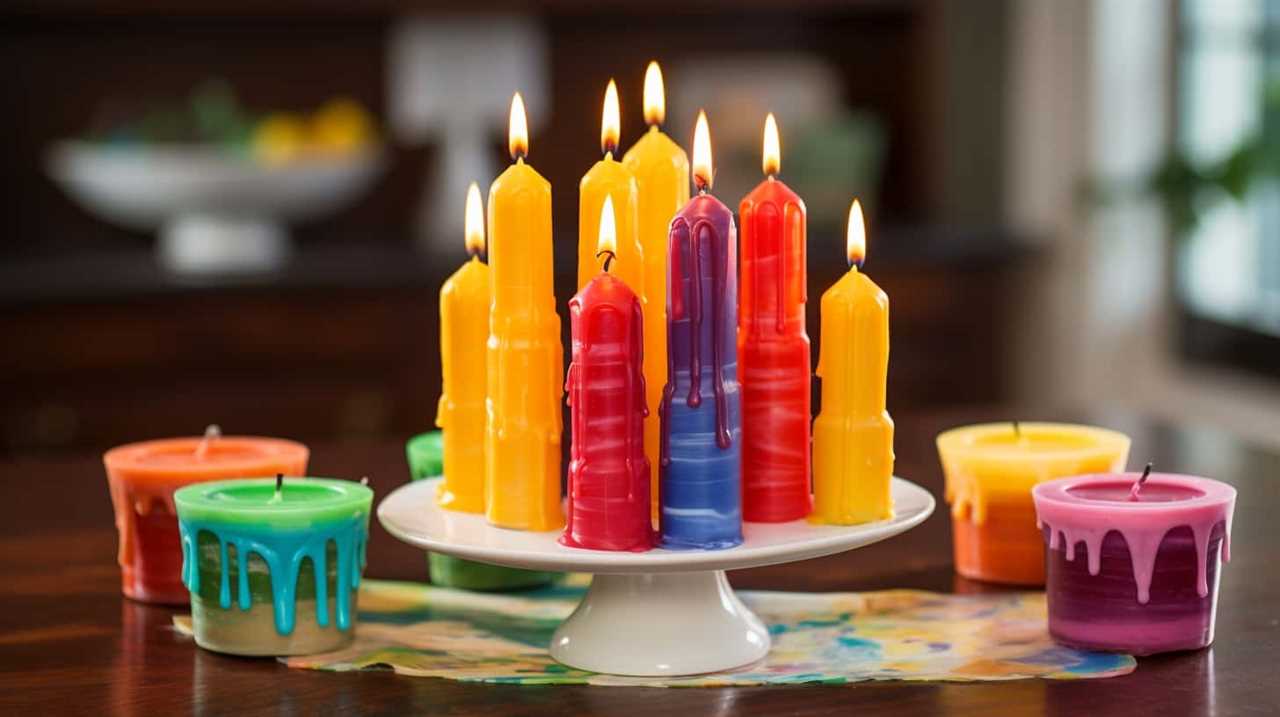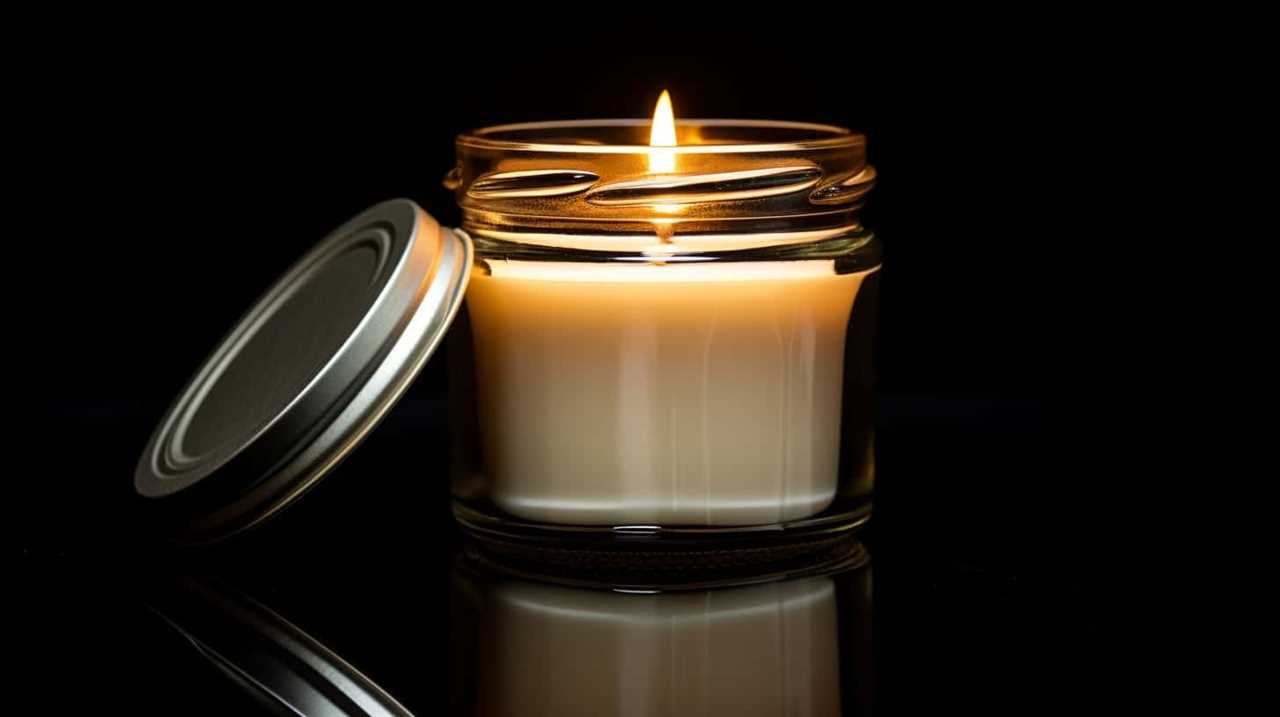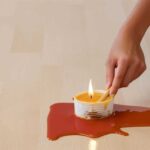Are you tired of the hassle of cleaning your candle wax warmer? No need to fret any longer! Keeping a clean candle wax warmer is an easy and rewarding chore that will ensure your space remains pleasantly scented and welcoming.
In this guide, we will show you how to clean your wax warmer effectively and efficiently. With just a few supplies and a little bit of time, you’ll have your wax warmer looking brand new in no time.
We understand the importance of serving others and creating a warm and welcoming atmosphere, so let’s get started on keeping your candle wax warmer clean and ready for use.
Key Takeaways
- The wax warmer can be cleaned using various techniques such as heating methods, wiping away melted wax, and freezing the wax.
- Wax removal can be done using a hot iron, freezing the wax and scraping it off, employing alternative cleaning methods, heating the wax slightly, or using a vinegar and water solution.
- To prevent wax buildup, it is important to gently scrape off residue, wipe away loose wax, freeze the wax, use a hairdryer on low heat, or use a vinegar and water solution.
- Proper cleaning and maintenance of the wax warmer include gently scraping off hardened wax, using a safe cleaner, regularly cleaning the dish, avoiding sharp objects, and performing regular maintenance for optimal performance and longevity.
Gather Necessary Supplies
To prepare for cleaning the candle wax warmer, we’ll gather the necessary supplies. It’s important to have the right tools on hand to efficiently and effectively remove any wax buildup and keep your warmer in pristine condition.

Firstly, you’ll need a heat source to melt the wax. A hairdryer or a heat gun can be used for this purpose.
Additionally, have a soft cloth or paper towel ready to wipe away the melted wax.
To prevent future wax buildup, it’s recommended to use wax melts or liners in your warmer. These will catch any melting wax, making the cleaning process much easier.
Remove Any Leftover Wax
Now that we’ve gathered our necessary supplies, let’s move on to the next step: removing any leftover wax from the candle wax warmer.

There are a few different methods you can use to heat up the wax and make it easier to remove, such as using a hairdryer or placing the warmer in a warm water bath.
Once the wax is melted, you can simply wipe it away with a paper towel or cloth.
Heating Methods for Wax
We can remove any leftover wax from the candle wax warmer by using different heating methods. Here are some alternative methods you can try:
- Using a hairdryer: Set your hairdryer to a low heat setting and aim it at the hardened wax. As the wax begins to melt, use a paper towel or cloth to wipe it away.
- Using hot water: Fill a basin with hot water and place the wax warmer in it. Let it sit for a few minutes until the wax softens. Then, use a cloth or sponge to remove the wax from the warmer.
- Freezing the wax: Place the wax warmer in the freezer for a couple of hours. Once the wax is frozen, gently tap it to break it into smaller pieces. Then, use a spoon or a butter knife to remove the wax fragments.
- Using a candle warmer: Place the wax warmer on top of a candle warmer and allow the residual heat to melt the wax. Once melted, carefully wipe away the wax with a paper towel.
These heating techniques will help you remove any leftover wax and keep your candle wax warmer clean and ready for use.

Wax Removal Techniques
To remove any leftover wax from the candle wax warmer, we can employ various wax removal techniques. One effective method is to heat the wax slightly, making it easier to remove. Place a paper towel or cloth over the hardened wax and gently run a hot iron over it. The heat will melt the wax, allowing it to be absorbed by the paper towel or cloth.
Alternatively, you can freeze the wax by placing an ice pack or bag of ice on top of it. Once the wax becomes brittle, carefully scrape it off with a plastic scraper or credit card. These alternative cleaning methods are quick and efficient in removing any stubborn residue.
By using these techniques, you can ensure a clean and well-maintained candle wax warmer.
Now, let’s move on to the next section about preventing wax buildup.

Preventing Wax Buildup
To prevent wax buildup and remove any leftover residue, we can use an eraser or a rubber tool to gently scrape off the wax from the surface of the candle wax warmer. This simple step will help maintain a clean wax warmer and ensure that it functions properly.
Here are some wax removal hacks to keep in mind:
- Use a soft cloth or paper towel to wipe away any loose wax before it hardens.
- Place the wax warmer in the freezer for a few minutes to harden the wax, making it easier to remove.
- Use a hairdryer on low heat to melt the wax slightly, then wipe it away with a cloth.
- For stubborn wax buildup, mix equal parts vinegar and water, then apply the solution to the affected area and wipe clean.
Clean the Wax Warmer Dish
Now let’s focus on cleaning the wax warmer dish.
The first step is to remove any hardened wax by gently scraping it off with a non-abrasive tool, such as a plastic spatula.

Next, choose a cleaner that’s safe for the dish material, such as warm soapy water or a vinegar solution.
Regularly cleaning the dish will help prevent future wax buildup and keep your wax warmer looking and functioning its best.
Removing Hardened Wax
We remove hardened wax from the wax warmer dish by gently scraping it off with a plastic scraper or credit card.
To effectively clean the wax warmer dish, follow these simple steps:

- Use heating techniques: If the wax has hardened and is difficult to remove, you can place the dish in the freezer for a few minutes. This will cause the wax to contract and become easier to scrape off.
- Try wax removal products: For stubborn wax residue, you can use wax removal products specifically designed for candle wax warmers. These products can help dissolve the wax and make it easier to remove.
- Avoid using sharp objects: It’s important to use a plastic scraper or credit card to avoid scratching or damaging the wax warmer dish. Sharp objects can cause permanent marks or even break the dish.
- Clean regularly: To prevent the wax from hardening and becoming difficult to remove, it’s recommended to clean the wax warmer dish after each use. Regular cleaning will make the process much easier and prevent any buildup.
Choosing the Right Cleaner
After removing the hardened wax from the wax warmer dish, it’s important to choose the right cleaner for effectively cleaning the dish. There are various cleaning techniques you can use, but it’s always a good idea to opt for natural alternatives. These cleaners aren’t only safe for your health and the environment, but they also do a great job of removing any residue left behind.
One popular natural cleaner is a mixture of vinegar and water. Simply mix equal parts of vinegar and water, then use a cloth or sponge to wipe down the dish.
Another option is to use baking soda. Sprinkle some baking soda onto a damp cloth and gently scrub the dish. These natural cleaners aren’t only effective but also affordable and easily accessible.
By choosing the right cleaner, you’ll ensure a thorough and safe cleaning process for your wax warmer dish.

To prevent future buildup and keep your wax warmer dish clean, it’s important to establish a regular cleaning routine.
Preventing Future Buildup
To maintain a clean wax warmer dish and prevent future buildup, regular cleaning is essential. Here are some effective cleaning techniques to help you prevent wax buildup:
- Scrape off excess wax: After using your wax warmer, allow the wax to cool and solidify. Then, use a plastic scraper or a credit card to gently scrape off any remaining wax from the dish.
- Wipe with a soft cloth: Take a soft cloth or paper towel and wipe the dish to remove any residue or oil buildup. Be sure to clean all areas of the dish, including the sides and bottom.
- Use hot, soapy water: Fill a sink or basin with hot water and add a few drops of dish soap. Submerge the dish in the soapy water and let it soak for a few minutes. Then, use a sponge or brush to scrub away any remaining wax or residue.
- Dry thoroughly: After cleaning the dish, make sure to dry it thoroughly with a clean towel or allow it to air dry before using it again.
Use a Heat Source to Melt Stubborn Wax
Using a hairdryer or a heat gun is an effective method for melting stubborn wax in a candle wax warmer. When you encounter hardened wax that’s difficult to remove, applying heat can soften it and make it easier to clean.
Simply direct the heat source towards the hardened wax and allow it to melt. Be sure to keep the heat source at a safe distance to avoid damaging the wax warmer or causing any accidents.

As the wax melts, use a cloth or paper towel to wipe away the softened wax. This heating method for wax ensures that no residue is left behind, leaving your wax warmer clean and ready for the next use.
Wipe Down the Exterior of the Wax Warmer
Now let’s move on to the next step in cleaning your wax warmer: wiping down the exterior.
This is important for removing any residue or build-up that may have accumulated on the outside of the warmer. Simply take a clean, damp cloth and gently wipe down the surface, making sure to focus on any areas that may be particularly dirty or sticky.
This will help keep your wax warmer looking clean and well-maintained.

Removing Stubborn Residue
We can effectively remove stubborn residue from the exterior of the wax warmer by wiping it down. Here are some helpful tips to make the process easier and more efficient:
- Use a soft cloth or sponge: Gently wipe the exterior of the wax warmer using a soft cloth or sponge. This will help remove any residue without causing any damage to the surface.
- Warm, soapy water: Create a solution of warm water and mild soap. Dip the cloth or sponge into the soapy water and wring out any excess liquid. Wipe down the exterior of the wax warmer, focusing on areas with stubborn residue.
- Scrubbing brush: For tougher residue, you can use a soft-bristled scrubbing brush. Dip the brush into the soapy water and gently scrub the affected areas. Be careful not to scrub too hard as it may scratch the surface.
- Vinegar solution: If the residue persists, you can try using a vinegar solution. Mix equal parts of white vinegar and water. Dip the cloth or sponge into the solution and wipe down the exterior of the wax warmer. The acidity of the vinegar can help break down the residue.
Cleaning the Removable Dish
To clean the removable dish and wipe down the exterior of the wax warmer, we can follow a few simple steps.
First, unplug the wax warmer and allow it to cool completely. Once it’s cool, remove the dish from the warmer. If there are any leftover wax residues, gently scrape them off using a plastic spatula or a spoon. Be careful not to scratch the dish.
Next, wash the dish with warm soapy water, using a soft cloth or sponge. Rinse it thoroughly and dry it completely before placing it back into the wax warmer.

To wipe down the exterior of the wax warmer, use a damp cloth or sponge and gently wipe away any dirt or stains. Avoid using harsh chemicals or abrasive materials that can damage the surface.
With these simple cleaning techniques, your wax warmer will look as good as new.
Clean the Interior of the Wax Warmer
To effectively clean the interior of a wax warmer, gather the necessary supplies beforehand. Here are four items to help you get started:
- Soft cloth or sponge: Use this to wipe down the interior of the wax warmer.
- Mild dish soap: Mix a small amount with warm water to create a gentle cleaning solution.
- Cotton swabs: These are perfect for reaching into small crevices and corners.
- Toothpicks: They can be used to gently scrape off any stubborn residue.
When cleaning the interior of your wax warmer, it’s important to be cautious with the heating techniques and delicate components. Avoid using abrasive cleaning tools that could damage the heating element or other sensitive parts. Instead, opt for gentle cleaning tools like the ones mentioned above.

Once the interior is cleaned, you can move on to removing any residue with rubbing alcohol, which will be discussed in the next section.
Remove Any Residue With Rubbing Alcohol
To remove any residue from the interior of the wax warmer, pour rubbing alcohol onto a soft cloth and gently wipe the affected areas. Rubbing alcohol is an effective solution for removing stubborn wax buildup and residue. It acts as a solvent, breaking down the wax and making it easier to remove.
Additionally, rubbing alcohol evaporates quickly, leaving no residue behind. If you prefer natural wax cleaner options, you can use vinegar or lemon juice mixed with water. These natural alternatives are gentle on the wax warmer and safe to use.
Once you have finished wiping the interior with rubbing alcohol or a natural cleaner, proceed to the next step: drying and polishing the wax warmer.

Dry and Polish the Wax Warmer
Now we need to dry and polish the wax warmer. After cleaning the wax warmer, it’s important to ensure it’s completely dry before using it again. Here are some steps to help you dry and polish your wax warmer:
- Use a clean, dry cloth to gently pat dry the wax warmer.
- Allow the wax warmer to air dry for a few minutes to ensure any remaining moisture evaporates.
Once dry, use a soft, lint-free cloth to polish the wax warmer. This will give it a nice shine and remove any fingerprints or smudges. Pay extra attention to the edges and corners of the wax warmer to ensure all areas are properly polished.
Maintain a Clean Wax Warmer
After drying and polishing the wax warmer, we can now focus on maintaining its cleanliness. Regular maintenance is key to keeping your wax warmer in good working condition and ensuring optimal heating techniques. Here are some simple wax warmer maintenance tips to follow:
| Maintenance Tips | Frequency |
|---|---|
| Clean the interior and exterior | Every 2-3 uses |
| Remove any melted wax residue | After each use |
| Replace wax dish or liners | As needed |
| Clean the heating element | Monthly |
| Inspect the power cord and plug | Regularly |
Troubleshooting Tips for Stubborn Residue
If you’re dealing with stubborn residue in your wax warmer, try using a soft cloth or sponge soaked in warm, soapy water. Here are some troubleshooting techniques to help you remove tough stains:

- Scrub gently: Use the cloth or sponge to scrub the residue, applying light pressure. Avoid using abrasive materials that could scratch the surface of your wax warmer.
- Vinegar solution: Mix equal parts white vinegar and water. Dampen the cloth or sponge with the solution and gently scrub the residue. Rinse thoroughly afterward.
- Baking soda paste: Make a paste by mixing baking soda with a small amount of water. Apply the paste to the residue and let it sit for a few minutes. Scrub gently and rinse well.
- Lemon juice: Squeeze fresh lemon juice onto the residue and let it sit for a few minutes. Wipe away the residue with a cloth or sponge soaked in warm water.
Remember to always dry your wax warmer thoroughly before using it again.
These techniques should help you tackle stubborn residue and keep your wax warmer clean and fresh.
Frequently Asked Questions
How Often Should I Clean My Wax Warmer?
We clean our wax warmer regularly to ensure optimal performance and longevity. By maintaining a consistent cleaning frequency, we prevent wax buildup and prolong the lifespan of the warmer.
Can I Use Soap and Water to Clean the Wax Warmer Dish?
Yes, soap and water can be used to clean the wax warmer dish. However, there are alternative cleaning methods available that may be more effective. Let us share some tips on how to keep your wax warmer spotless!

What Is the Best Way to Remove Wax Residue From the Exterior of the Wax Warmer?
Removing wax stains from the exterior of the wax warmer is best done by gently scraping off any excess wax and then using a cloth dampened with rubbing alcohol to clean the surface.
Is It Safe to Use Rubbing Alcohol on the Interior of the Wax Warmer?
Using rubbing alcohol on the interior of your wax warmer may not be safe. However, there are alternative cleaning methods you can try, such as using vinegar or warm soapy water to remove wax residue effectively.
How Can I Prevent Residue Buildup in My Wax Warmer?
To prevent residue buildup in our wax warmer, we’ve found simple cleaning techniques that work wonders. Regularly wiping down the interior with a damp cloth and using a scraper for stubborn wax will keep it looking and functioning like new.
Conclusion
In conclusion, keeping your wax warmer clean is essential for optimal performance and longevity.

Did you know that a study conducted by the National Candle Association found that regular cleaning can extend the lifespan of your wax warmer by up to 30%?
By following the simple steps outlined in this article, you can ensure that your wax warmer stays in great condition, providing you with hours of delightful fragrance.
















